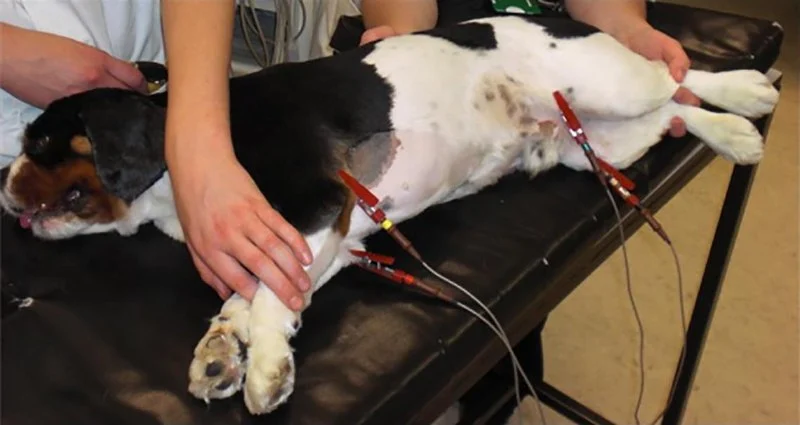
The Adoption of Wearable EKG / Heart Monitors for Dogs & Cats
- 1 - Introduction to Wearable EKG and Heart Monitors for Pets
- 2 - Benefits of Using Wearable Heart Monitors for Dogs and Cats
- 3 - How Wearable Heart Monitors Work for Pets
- 4 - Case Study: Improving Pet Health with Wearable EKG Monitors
1 - Introduction to Wearable EKG and Heart Monitors for Pets
The use of wearable EKG (electrocardiogram) and heart monitors in pets, especially dogs and cats, is becoming more popular as a way to monitor and manage their heart health. These devices are designed to provide continuous monitoring, making it easier for pet owners and veterinarians to detect and respond to potential heart issues before they become serious.
1.1 Why Wearable Heart Monitors Matter for Pets
Heart conditions in pets, particularly older dogs and cats, can be difficult to detect without specialized equipment. Wearable heart monitors offer a non-invasive and convenient way to keep track of your pet’s heart rate, rhythm, and overall cardiovascular health. This is especially important as pets age, or if they have a known heart condition.
1.2 Rise of Technology in Pet Health Care
Technology in pet care is evolving rapidly, and the adoption of wearable devices like heart monitors is part of this trend. As pet owners become more invested in their pets' health, they seek out ways to monitor and manage conditions that may go undiagnosed without continuous observation.
2 - Benefits of Using Wearable Heart Monitors for Dogs and Cats
Wearable EKG and heart monitors offer several advantages for pets and their owners. These benefits extend beyond heart health monitoring and into areas like early detection and ongoing care management.
2.1 Early Detection of Heart Conditions
One of the biggest advantages of wearable heart monitors is their ability to detect heart issues early. Conditions like arrhythmia, heart murmurs, and irregular heartbeats can be caught in their earliest stages, allowing for quicker intervention and more effective treatment.
2.2 Continuous Monitoring for Chronic Conditions
For pets with known heart conditions, continuous monitoring allows for real-time data that can inform treatment decisions. By having a clear picture of how your pet’s heart is functioning on a daily basis, veterinarians can adjust medications or treatments to better suit their needs.
2.3 Non-Invasive and Comfortable
Unlike traditional heart monitoring methods, such as those requiring clinic visits or sedation, wearable heart monitors are non-invasive and comfortable. They can be worn for extended periods, allowing pet owners to gather valuable data without putting their pets through stressful procedures.
2.4 Peace of Mind for Pet Owners
Knowing that you can monitor your pet’s heart health at any time provides peace of mind. Whether you are at home or away, having access to heart rate data and alerts can help you make informed decisions about your pet’s health care, reducing the anxiety that often comes with worrying about undetected conditions.
3 - How Wearable Heart Monitors Work for Pets
Wearable EKG and heart monitors for pets typically consist of a lightweight, adjustable band or harness that is fitted with sensors. These sensors track the heart’s electrical activity, sending data to an app or device that the pet owner or veterinarian can monitor in real-time.
3.1 Types of Wearable Heart Monitors
There are several types of wearable heart monitors available, each designed for different needs. Some are designed for continuous monitoring, while others may only need to be worn at specific times or during exercise. The most advanced devices are equipped with wireless capabilities, allowing pet owners to receive alerts and track data remotely.
3.2 Features of Wearable EKG Monitors
Common features of wearable heart monitors for pets include:
- Real-time heart rate and rhythm monitoring
- Data storage for historical health trends
- Notifications for abnormal heart patterns or irregularities
- Easy-to-use mobile apps for pet owners to access data
These features provide a comprehensive view of your pet’s cardiovascular health, which can be used for preventative care or immediate intervention if necessary.
4 - Case Study: Improving Pet Health with Wearable EKG Monitors
Meet Max, a 10-year-old Labrador who had been showing signs of lethargy and shortness of breath. His owner, Linda, was concerned that Max might be suffering from a heart condition but was unsure of the extent of his issues. After consulting with her veterinarian, Linda decided to try a wearable heart monitor to better understand Max's health.
4.1 Initial Monitoring and Data Collection
The heart monitor provided real-time heart rate data and alerted Linda whenever Max's heart rate became irregular. Over the course of a few weeks, the monitor revealed that Max was experiencing episodes of arrhythmia that were not apparent during routine visits to the vet.
4.2 Adjusting Treatment Based on Data
Armed with the data from the monitor, Linda and her veterinarian were able to adjust Max’s medication and monitor his response. The wearable monitor gave both Linda and the veterinarian the confidence that they were providing the best care possible for Max's heart condition.
Thanks to the wearable heart monitor, Max's condition was detected early, and he was able to receive timely treatment that helped improve his quality of life.
If you’re considering a wearable heart monitor for your pet, be sure to check out Pet & Puppy for the best selection of pet health technology and accessories designed to support your pet’s heart health.









 Princeton Veterinary Hospital4.0 (821 reviews)
Princeton Veterinary Hospital4.0 (821 reviews) Thomas Ridge Kennels4.0 (17 reviews)
Thomas Ridge Kennels4.0 (17 reviews) All Creatures Animal Hospital4.0 (354 reviews)
All Creatures Animal Hospital4.0 (354 reviews) Fatty Paws Pet Boutique0.0 (0 reviews)
Fatty Paws Pet Boutique0.0 (0 reviews) CityVet | Lone Mountain Veterinary & Urgent Care4.0 (104 reviews)
CityVet | Lone Mountain Veterinary & Urgent Care4.0 (104 reviews) Petnificent Picks5.0 (1 reviews)
Petnificent Picks5.0 (1 reviews) How to Transition a Senior Pet to Easier-to-Eat Food: A Comprehensive Guide
How to Transition a Senior Pet to Easier-to-Eat Food: A Comprehensive Guide The Hidden Dangers in Common Pet Supplies: What You Need to Know
The Hidden Dangers in Common Pet Supplies: What You Need to Know Managing Chronic Conditions in Pets: Essential Diet, Medication & Lifestyle Tips
Managing Chronic Conditions in Pets: Essential Diet, Medication & Lifestyle Tips How to Build a Pet Emergency Kit: Essentials You Need
How to Build a Pet Emergency Kit: Essentials You Need Best Practices for Pet Grooming Frequency by Breed: Keeping Your Pet’s Coat Healthy
Best Practices for Pet Grooming Frequency by Breed: Keeping Your Pet’s Coat Healthy The Effect of Seasonal Allergies on Pets & How to Help
The Effect of Seasonal Allergies on Pets & How to Help